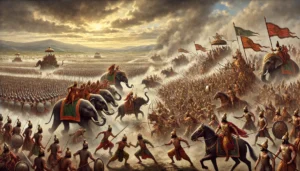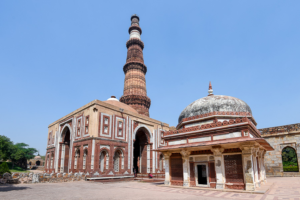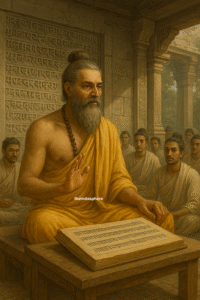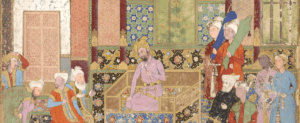
The Buddhist Kuchi Kingdom, also known as the Kucha Kingdom, was a significant center of Buddhism on the northern Silk Road and once stood as a beacon of culture, spirituality, and commerce. From the 2nd century BCE to the 8th century CE, Kucha flourished as a melting pot of Indian, Iranian, and Chinese influences, fostering a unique blend of art, language, and religious devotion. Though often overshadowed by other great Buddhist centers like Nalanda and Dunhuang, Kucha played a vital role in the transmission of Buddhism from India to China.
This article explores the rich legacy of Kucha, its contributions to Buddhist philosophy and art, its rulers, its connections to Indian and Chinese kingdoms, and its eventual decline in the face of changing political and religious landscapes.
The Strategic Location of Kucha
Kucha was located in present-day Xinjiang Uyghur Autonomous Region, China, along the northern Silk Road. Its strategic position made it a crucial hub for trade and cultural exchange between China, India, Persia, and the Mediterranean world. Merchants and pilgrims traveling between these civilizations frequently passed through Kucha, leading to the kingdom’s prosperity and the diffusion of religious ideas. It also acted as a resting place for Buddhist monks and travelers moving between India and China, strengthening its role as a Buddhist center.
The Origins of Kingdom of Kucha
The Kingdom of Kucha is believed to have been established around the 2nd century BCE, emerging as a dominant power in the Tarim Basin. Kucha was one of the Thirty-six Kingdoms of the Western Regions, an important network of city-states that flourished along the Silk Road. Its strategic location allowed it to control vital trade routes, making it one of the wealthiest and most influential states in Central Asia.
The early history of Kucha is somewhat obscure, but historical Chinese records and Buddhist texts mention it as a kingdom with Indian, Iranian, and Central Asian influences. Kucha’s ruling elite adopted Buddhist teachings, likely influenced by the flow of monks and traders from India and Gandhara. By the 1st century CE, Kucha had become a major center of Buddhist learning, with temples and monasteries spreading across the region.

Timeline of the Kucha Kingdom:
- 1st century BCE – 4th century CE: Early development of Kucha as a Buddhist center, influenced by Indian and Iranian cultures.
- 4th–7th centuries CE: Peak of the Kucha Kingdom; it became one of the most important Buddhist kingdoms in the Tarim Basin, known for its monasteries, murals (e.g., Kizil Caves), and Buddhist scholars like Kumarajiva.
- 648 CE: The Tang Dynasty, under General Ashina She’er, conquered Kucha and integrated it into the Tang protectorate of the Anxi (Western Regions).
- 8th century CE: Decline of Kucha due to conflicts, especially the Tibetan expansion and the rise of Islam in Central Asia.
By the late 8th century, Kucha had lost its Buddhist prominence, and by the 10th–11th centuries, it had become largely Islamic under the Kara-Khanid Khanate.
The Rulers of Kingdom of Kucha and Their Influence
The kings of Kucha played a significant role in shaping the kingdom’s religious, military, and diplomatic policies. Many rulers supported Buddhist expansion while also maintaining political alliances with China, India, and other Central Asian states. Some of the most notable rulers include:
- King Suvarnadeva (7th century CE): Known for his diplomatic ties with the Tang Dynasty, he actively promoted Buddhism and strengthened the kingdom’s position in Central Asia. His reign marked a period of relative stability and prosperity.
- King Visa Sambhava (possibly 3rd-4th century CE): Mentioned in Buddhist texts, he was a patron of Buddhism and contributed to the development of monasteries in Kucha.
- King Suvarnapuspa: A ruler who played a role in preserving Buddhist teachings and maintaining Kucha’s independence for a time.

Despite their Buddhist patronage, Kucha’s kings also had to deal with military threats from neighboring states. Their rule was often contested by powerful empires like the Xiongnu, Han Dynasty, Tibetans, and the Tang Dynasty, which sought control over the Silk Road.
The Spread of Buddhism in Kucha
Buddhism reached Kucha from India via Central Asia, carried by traders and monks who traveled along the Silk Road. The kings of Kucha, realizing the growing influence of Buddhism, gradually adopted and patronized the religion. By the 2nd and 3rd centuries CE, Kuchan rulers actively supported Buddhist monasteries and scholars, promoting the construction of temples and cave complexes like the Kizil Caves.
Royal patronage played a crucial role in Kucha’s transformation into a Buddhist stronghold. The Kuchan kings were known for their devout support of Buddhist philosophy, commissioning translations of Sanskrit texts into the local Tocharian language and sponsoring visiting monks from India. Many rulers personally funded the expansion of Buddhist monasteries and temples, ensuring the widespread presence of Buddhism throughout their kingdom.
Art and Architecture: The Kizil Caves
The Kizil Caves, located near Kucha, are among the earliest Buddhist rock-cut cave complexes in China, dating back to the 3rd to 8th centuries CE. These caves contain stunning murals and sculptures that showcase a fusion of Indian, Persian, and Greek artistic influences. The caves served as important monastic retreats and centers of learning, where monks studied scriptures and meditated.

Key Features of Kizil Caves:
- Murals: The frescoes in Kizil are noted for their vivid colors and detailed depictions of Buddhist legends, Jataka tales, and celestial beings. They provide insight into the daily lives of monks, Buddhist cosmology, and the moral teachings of Buddhism.
- Gandhara and Gupta Influences: The artistic style reflects influences from Gandhara (Greco-Buddhist art) and Gupta Empire, with graceful figures, elaborate draperies, and narrative storytelling. The depictions of the Buddha and Bodhisattvas showcase clear Indian artistic traditions.
- Distinctive Features: Unlike the later Dunhuang caves, Kizil’s art is marked by the use of non-Chinese facial features, haloed figures, and a unique blue-green color palette.
- Monastic Chambers and Stupas: Many of the caves were used as meditation chambers for monks, and some even contained stupas, reinforcing their role as religious centers.
- Painted Ceilings: Some of the caves have intricate painted ceilings that depict elaborate geometric patterns, heavenly realms, and Buddhist stories, indicating the influence of both Persian and Indian art.
- Mahāyāna Themes: Many of the murals in the Kizil Caves illustrate Mahāyāna Buddhist themes, such as Bodhisattvas practicing compassion and the idea of the Buddha’s numerous past lives leading up to his enlightenment.

Indian Paintings and Artistic Influence in the Kizil Caves
The murals of the Kizil Caves are among the most significant examples of early Buddhist art in Central Asia, showing profound influences from Indian artistic traditions. Several paintings in these caves resemble Ajanta Caves in India, particularly in their use of vibrant colors, narrative storytelling, and depiction of divine figures.

Indian Artistic Elements Found in Kizil Caves:
- Jataka Tales: Many murals depict scenes from the past lives of the Buddha, a recurring theme in Indian Buddhist art. These stories, which illustrate moral lessons, were widely depicted in Indian cave paintings at Ajanta and Sanchi.
- Bodhisattva Figures: The representation of Bodhisattvas with elaborate crowns, jewelry, and graceful postures is influenced by Gupta-era Indian art.
- Narrative Panels: The murals follow the Indian storytelling technique of sequential panel depictions, similar to those found in Ajanta, where different stages of a story are illustrated in a single frame.
- Buddha Images: The seated or standing Buddha with a halo, long flowing robes, and symbolic hand gestures (mudras) strongly resembles Gandharan and Mathuran sculptures from India.
- Color Techniques: The use of deep reds, blues, and ochres reflects Indian artistic traditions, particularly the techniques employed in Gupta and Ajanta paintings.
These elements indicate that Kucha was heavily influenced by Indian Buddhist art, either through direct contact with Indian artists and monks or by importing artistic styles and techniques via traveling pilgrims and merchants.

The Significance of the Kizil Caves
The caves were not just places of worship but also served as centers of religious education and cultural synthesis. The presence of Tocharian inscriptions, along with Sanskrit and Chinese writings, indicates that the monks who lived in these caves were engaged in translating and transmitting Buddhist scriptures across linguistic and cultural boundaries.
Buddhist travelers such as Xuanzang, the famous 7th-century Chinese monk, recorded detailed accounts of the Kizil Caves, praising their artistic excellence and religious significance. His descriptions help modern scholars understand the historical and religious context of these sites.
As Buddhism declined in Central Asia due to political changes and the spread of Islam, the caves were gradually abandoned. However, their murals and structures remain one of the best-preserved legacies of Buddhist civilization in the region. Today, the Kizil Caves provide scholars and archaeologists with invaluable information about the early spread of Buddhism, cross-cultural exchanges on the Silk Road, and the artistic innovations that flourished in this unique Buddhist kingdom.
Conflicts, Wars, and Political Struggles
Wars with the Chinese Han Dynasty
During the 2nd century CE, Kucha came into contact with the expanding Han Dynasty of China. The Chinese sought to secure control over the Western Regions, including Kucha, to protect their trade interests.
Ban Chao’s Campaign (1st century CE): The famous Chinese general Ban Chao led military campaigns to bring Kucha and other city-states under Han control. After fierce resistance, Kucha was forced to recognize Han authority and became a tributary state.
Conflict with the Rouran and Göktürks
In the 5th and 6th centuries CE, Kucha faced invasions from the Rouran Khaganate and later the Gokturks, nomadic steppe empires that sought to dominate the Silk Road trade routes. These conflicts weakened Kucha’s power, forcing its rulers to seek alliances with China and India for protection.
Tang Dynasty Invasion and Annexation
By the 7th century CE, Kucha had become a key target for the expanding Tang Dynasty (618–907 CE). The Tang sought direct control over Central Asia and launched military campaigns to subjugate the region.
- Tang Conquest of Kucha (648 CE): In one of the most significant events in Kucha’s history, the Tang general Xue Rengui led an army against the kingdom. After heavy fighting, the Tang forces captured Kucha and deposed its ruler, making it a military outpost of the Tang Empire.
- Rebellions Against Tang Rule: Despite being under Tang control, Kucha remained rebellious. Several local uprisings occurred, with Kuchan leaders attempting to regain independence, but these were brutally suppressed by Tang forces.
Interaction with Tibet and the Decline of Kucha
During the 8th century CE, as the Tibetan Empire expanded into Central Asia, Kucha found itself caught between the rivalries of the Chinese Tang Dynasty and Tibetan forces. Eventually, Tibetan incursions further destabilized the region, and Kucha’s Buddhist monasteries began to decline.
By the 10th-11th centuries CE, the region saw the rise of Islamic influence as the Kara-Khanid Khanate, a Turkic Muslim empire, conquered much of the Tarim Basin. With this conquest, Buddhism in Kucha gradually disappeared, replaced by Islamic traditions.
The Fall of Kucha
The final blow to Kucha came in the 12th century, as Islam had become the dominant religion in the region. Buddhist monasteries were abandoned, and the artistic and religious traditions that had once flourished were either destroyed or assimilated into the new cultural landscape. Over time, Kucha became a part of various Turkic and Mongol states, losing its unique identity as an independent Buddhist kingdom.
The Enduring Legacy of Kucha
Although Kucha as a kingdom disappeared, its cultural, religious, and artistic contributions remain influential. The Kizil Caves, the teachings of Kumarajiva, and the preserved Buddhist manuscripts serve as reminders of Kucha’s historical importance.
Kucha’s Influence in Modern Times:
- The Kumarajiva translations continue to shape Buddhist thought in China, Korea, and Japan.
- The Kizil murals provide valuable insights into cross-cultural artistic influences in ancient Asia.
- Archaeologists and historians study Kuchan ruins to understand early Buddhist societies in Central Asia.
- Linguists examine Tocharian manuscripts, offering insights into one of the world’s lost Indo-European languages.
The Buddhist Kingdom of Kucha was a thriving cultural and religious center that played a key role in the spread of Buddhism across Asia. Despite its decline, its artistic, linguistic, and spiritual contributions remain invaluable. As interest in Silk Road history grows, Kucha’s forgotten legacy is once again being rediscovered, reminding us of the deep interconnections between ancient civilizations.







